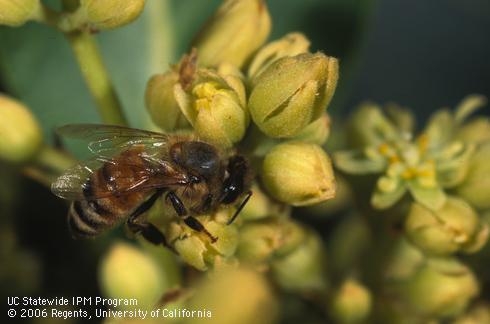By Brittney Goodrich, Assistant Cooperative Extension Specialist, Agricultural and Resource Economics, University of California, Davis
If you own or manage a commercial avocado orchard, you have likely debated at one point or another whether to seek out honey bee colonies to pollinate your orchard, and how much to pay the beekeeper for those pollination services. A recent academic paper published in the Journal of Applied Entomology summarizes findings regarding the role of insect pollination in avocado production, and I would encourage you to take a look, especially if you have not sought out honey bee colonies in the past (see Dymond et al., 2021 referenced at end of article). Dymond et al. conclude that “In 19 out of 23 studies, insect pollinators contributed significantly to pollination, fruit set and yield.” And “In most situations, growers will benefit from an increased density of pollinators.” However, they note that renting honey bee colonies may not make economic sense for every orchard. In this article, I'll touch on some factors that may influence a grower's decision to place honey bee colonies in avocado orchards for pollination services.
Are managed honey bee colonies needed in your orchard?
Given the conclusions of Dymond et al. (2021), if you are a grower who has not placed honey bee colonies in your avocado orchard in the past, this may be something to consider going forward. Though, doing so may not guarantee increases in yield because your orchard has likely been receiving pollination services from wild pollinators and/or honey bee colonies located nearby. If your orchard is located near natural pollinator habitat, you may receive sufficient wild pollinators to obtain significant fruit set, in which case additional bees may not be necessary. Foraging honey bees typically seek out the least competitive forage sources, so if your orchard without honey bee colonies is located near an orchard in which the grower paid for pollination services, it is likely you are “borrowing” bees from your neighbor's orchard. In that situation, bringing in managed honey bees may not make the most economic sense from your perspective, but it may make your neighbor happy!
Supply of honey bee colonies
Depending on location, avocado bloom can begin in late March/early April and last through May/June (Bender, 2013). One important factor in the availability of honey bee colonies for pollination services for avocado bloom is the number of colonies in California at the end of almond bloom. In 2020, roughly 2.4 million colonies were required to pollinate California's almond orchards, far exceeding the number of colonies that remain in California year-round. This means roughly 2 million colonies were shipped in to California to meet this demand. This number makes up approximately 88% of the total number of colonies in the U.S., so beekeepers bring colonies from as far as New York and Florida to meet these needs (Goodrich and Durant, 2020; Goodrich, 2019).
For avocado growers, this means at the very beginning of avocado bloom, there may still be a surplus of bees left in California. Beekeepers from northern states, e.g., North Dakota, South Dakota, and Montana, can't transport colonies back right away given there may still be snow on the ground and little blooming for the bees to forage on. However, as spring progresses throughout the rest of the U.S., the number of bees in California begins to decrease substantially. Looking at the U.S. Department of Agriculture (USDA) Honey Bee Colonies Report, on April 1, 2018, there were 1.1 million colonies in California and by July 1, 2018 the number of colonies was nearly half that at 590,000.
Traditionally, California beekeepers would place colonies in or near citrus orchards for honey production after almond bloom (Champetier, 2010). In addition to being good for bees (and their keepers), this practice has benefitted growers of nearby crops that require pollination services. For example, a beekeeper might place colonies for no charge in an avocado orchard that needs pollination services simply to gain access to the prime honey-producing location. However, given the surplus of colonies remaining in California after almond bloom, I suspect (notably without any direct empirical evidence) these locations are not as prime as they once were. Supporting evidence for my theory is shown in Figures 1 and 2. Figure 1 displays a fairly prominent downward trend in total honey-producing colonies in California since 1990, and over the same time period, the average amount of honey produced per colony in California has trended downward as well. If the essential inputs to honey production, i.e., floral nectar and pollen sources, were roughly equivalent over this time period, one would expect for honey production per colony to increase as the number of colonies decreases given the lower competition over floral sources. Figure 2 shows bearing citrus acreage over this time period. Citrus acreage has decreased since the late 1990s, which might partially explain lower honey production per colony in recent years. However, the decreasing trend in honey production per colony occurred even in the late 1990s when citrus acreage in California was increasing. These trends suggest that the influx of bee colonies due to almond pollination requirements have encroached on forage resources previously utilized by California beekeepers, lowering their potential for honey production. Again, I caveat the previous suggestion with the fact that I have not yet directly tested this hypothesis, so these relationships could be coincidental.
Get the whole story at: http://ceventura.ucanr.edu/Com_Ag/Subtropical/
